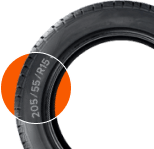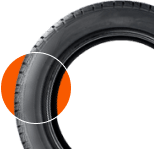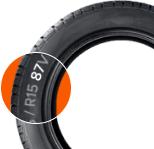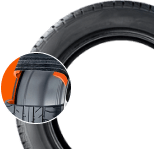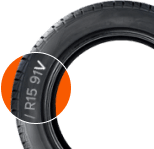Studded tyres
Search tires by size

Choosing a suitable tyre size for your car with a few parameters
Enter width, height, diameter of your tyres

If you have any questions or issues, please contact our support service
Studded tyres: features and types
When driving on ice, the risk of skidding is a few times higher. Often a driver can totally lose control over the vehicle. Studded tyres can help to avoid such situations. Here we tell you about the types of these tyres, and their advantages and disadvantages.
Why studded tyres are not permitted in some countries
The world’s first studded tyres appeared in the 1960s. They were produced by the Michelin company who earlier premiered the tread siping technology. These tyres ensured perfect grip on slippery roads. However, already in 1975, this kind of tyres were prohibited in some European countries. The reason for this were grooves made by the studs on paved surfaces. Formation of grooves increased the risk of hydroplaning, which was and remains a more serious problem in many European countries with relatively soft winters.
Nowadays, the use of studded tyres is prohibited in such countries as Montenegro, Croatia, Serbia, Slovakia, Slovenia, Bosnia and Herzegovina, Macedonia, Bulgaria, the Netherlands, Germany (with exception of some municipalities close to Austrian border), the Czech Republic, Hungary, Romania, Poland, and Portugal.
Driving on studded tyres in winter is allowed in Austria, the Republic of Albania, Belgium, Norway, Estonia, Finland, Denmark, Latvia, Lithuania, Luxembourg, France, Great Britain, Iceland, Ireland, Spain, Italy, Sweden, and Switzerland. However, many of these countries have their own studded tyre regulations. For instance, in Nordic countries, there is a law that restricts the allowable number of studs on a tyre to 50 per meter of circumference. In Austria, studded tires can only be used from the 1st of October to the 31st of May on cars below 3.5 tons, with limiting their speed to 100 km/h on highways and to 80 km/h on other roads. In Belgium, studs are only allowed from the 1st of November to the 31st of March, and with stricter speed limits: to 90 km/h on motorways and 60 km/h on other roads.
Types of studded tyres
- Studded. Their studs are factory-mounted. Such tyres are more durable, reliable, and long-lasting. However, they are expensive. In addition, it’s prohibited to use them without studs.
- Studabble. These tyres are supplied without studs, but feature mounting seats for installing them. These products are cheaper. But they are less effective than those of the first type. Studding of such tyres is performed at tyre shops. If necessary, the studs can be removed.
Advantages and disadvantages of studded tyres for cars
The main advantage of studded tyres is perfect grip on ice or packed snow. Their use prevents wheel spinning, ensures more confident acceleration, and contributes to shortening the braking distance.
However, studded tyres can be inferior to conventional friction tyres in grip on a paved surface, especially when it’s wet. Moreover, they are quite expensive and wear out faster. Such tyres are rather noisy when driving on asphalt and are less comfortable than non-studded items.
Popular models of studded tyres
- Michelin X-Ice North 4. These tyres feature more than 250 steel studs of a special shape, mounted according to a special pattern, which ensures perfect grip when driving on a slippery surface. A directional tread pattern provides excellent performance both on dry and wet asphalt.
- Nokian Hakkapeliitta LT3. These are tyres for light commercial vehicles. Their studs are made of stainless steel and characterized by high resistance to corrosion. A tread pattern with wide grooves ensures instant removal of water and snow from the contact patch, thus improving grip properties of the tyre.
- Cooper Weather-Master WSC. These tyres are designed for SUVs. They run quietly and are efficient both on slippery and dry surfaces. They are durable and long-lasting.


 B
70 dB
B
70 dB


 B
70 dB
B
70 dB


 B
70 dB
B
70 dB


 A
68 dB
A
68 dB


 B
70 dB
B
70 dB


 B
71 dB
B
71 dB


 B
70 dB
B
70 dB



 B
72 dB
B
72 dB



 B
70 dB
B
70 dB



 B
72 dB
B
72 dB



 B
70 dB
B
70 dB



 B
72 dB
B
72 dB



 B
70 dB
B
70 dB



 B
70 dB
B
70 dB


 B
70 dB
B
70 dB


 A
67 dB
A
67 dB



 B
69 dB
B
69 dB

Go to premium tyre brands selection
The most popular Auto tyres sizes
- 205/55 R16
- 225/40 R18
- 225/45 R17
- 195/55 R16
- 225/50 R17
- 205/45 R17
- 195/65 R15
- 185/65 R15
- 225/45 R18
- 215/50 R17









































